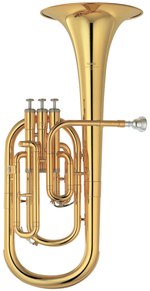Alto horn
| Alto horn | |
|---|---|
| english alto horn ( american ), tenor horn (british), french saxhorn alto or pichotte , italian genis or flicorno contralto | |
| E- flat alto horn | |
| classification |
Aerophone brass instrument |
| range |
 ( transposed notation ) |
The alto horn is a brass instrument from the family of bugles (Saxhorns), which around 1840 by Adolphe Sax invented.
The alto horn, which is similar in shape to the trumpet or tenor horn, has a conical brass tube about two meters long. It has three valves and is blown through a mug mouthpiece.
The alto horn is particularly used in brass and marching bands , where it takes on the role of the French horn in the alto and tenor register . In most cases Althörner are in it , rarely also in F voted . The pitch range extends from A to E2 (notated: f sharp to c 3 in the treble clef). The alto horn is a transposing instrument . (The alto horn in Eb, for example, sounds a major sixth lower than it is notated).
Alto horns have the advantage over the softer and more stable sounding horns that they are easier to play while marching and usually safer in difficult, fast or exposed passages. Furthermore, like all other brass instruments - with the exception of the horn - they are right-handed, which makes it easier to change instruments.
Today alto horns are mainly found in British bands. In Germany and Austria, the alto horn is usually played by trumpeters or horn players, as the local brass band scene is too small to concentrate solely on this instrument.
In the English-language brass band literature, the alto horn is sometimes referred to as the tenor horn - not to be confused with the German tenor horn , which is usually tuned a fourth lower in Bb.
Literature / works
- Paul Hindemith (composer): Sonata - for alto horn in E flat (French horn or alto saxophone ) and piano . (1943.) ED 4635. - EST : Sonatas, Hr, Kl (1943) . Schott, Mainz [a. a.] [2011?], DNB 1011394308 , ISMN 979-0-001-05414-0 (search in the DNB portal) ; [Piano score , parts ].
-
Philip Sparke (composer):
- Capricorno. Self-published , London ( solo piece for alto horn).
- Masquerade. Self-published, London (solo piece for alto horn).
Individual evidence
- ↑ Wieland Ziegenrücker: General music theory with questions and tasks for self-control. German Publishing House for Music, Leipzig 1977; Paperback edition: Wilhelm Goldmann Verlag, and Musikverlag B. Schott's Sons, Mainz 1979, ISBN 3-442-33003-3 , p. 176.
- ^ Robert Joseph Miller: Contemporary Orchestration: A Practical Guide to Instruments, Ensembles, and Musicians . Routledge, New York 2015, ISBN 978-0-415-74190-3 , pp. 125 ( limited preview in Google Book Search [accessed March 22, 2017]).
